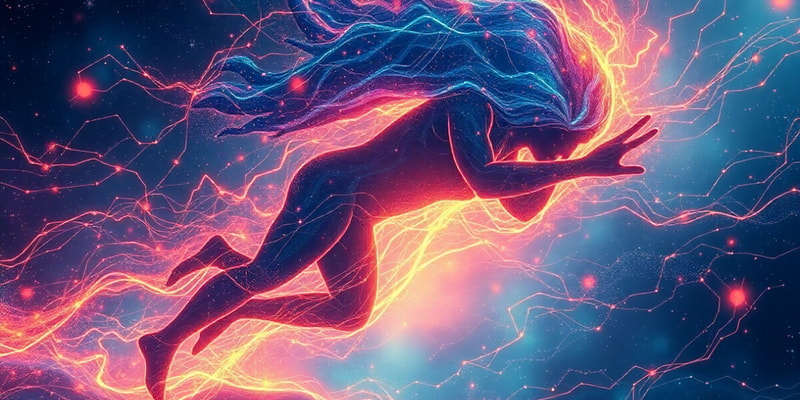Podcast Beta
Questions and Answers
What does the interpolated twitch technique assess?
What change occurs to motoneuron firing rate during maximum voluntary contraction (MVC) as fatigue progresses?
Which of the following can compensate for central fatigue during a task?
What impact does mental exertion before a physical task have according to early evidence?
Signup and view all the answers
What effect does full rest for 60 seconds have on fatigue components?
Signup and view all the answers
What physiological response is believed to occur when individuals are instructed to exert a 'super' effort?
Signup and view all the answers
How does muscle relaxation time change as fatigue develops during a sustained contraction?
Signup and view all the answers
What is a significant characteristic of central fatigue?
Signup and view all the answers
What effect do startling stimuli have on muscle contraction as observed in research?
Signup and view all the answers
Which of the following methods is typically used to investigate the effects of fatigue on muscle functions?
Signup and view all the answers
What is the main characteristic of central fatigue?
Signup and view all the answers
What does fatigability specifically measure?
Signup and view all the answers
What does evidence of electrical stimulation suggesting more force than maximum voluntary contraction indicate?
Signup and view all the answers
Why does the central nervous system (CNS) potentially retain reserve muscle force at higher force levels?
Signup and view all the answers
How does the amplitude of interpolated twitch relate to voluntary force?
Signup and view all the answers
According to previous studies, during what type of exercise do we experience a notable decline in motor performance?
Signup and view all the answers
What implication does the phenomenon of greater electrical stimulation response have on understanding muscle capacity?
Signup and view all the answers
What is a potential outcome of a high stress situation on muscle activation?
Signup and view all the answers
In the context of fatigue, what does the concept of 'reserve muscular force' refer to?
Signup and view all the answers
What does the rapid depletion of force at low levels of exertion suggest?
Signup and view all the answers
Which motor pathways are affected differently by fatigue?
Signup and view all the answers
What is a proposed factor of fatigue in exercising volunteers?
Signup and view all the answers
How does fatigue affect proprioceptive afferents?
Signup and view all the answers
What method can increase the accuracy of measuring maximal voluntary contractions (MVC)?
Signup and view all the answers
In the context of fatigue, what is the relationship between non-corticospinal inputs and motor neurons?
Signup and view all the answers
What is indicated about spinal stretch reflexes during maximal voluntary contraction (MVC)?
Signup and view all the answers
What should be varied to ensure subjects do not notice performance declines during MVC measurements?
Signup and view all the answers
What alteration occurs in muscle activity due to fatigue?
Signup and view all the answers
Which statement regarding the effects of fatigue on motor neuron firing characteristics is accurate?
Signup and view all the answers
What is one consequence of electrical stimulation in relation to fatigue?
Signup and view all the answers
Study Notes
Fatigue
- Fatigability is the rate of decline in motor performance (e.g. MVC force, reaction time, movement accuracy).
- Central fatigue is a reduction in voluntary activation or neural drive to the muscle.
- Electrical stimulation elicits more force than MVC after fatiguing exercise.
- We may have a reserve of muscular force not used in normal circumstances.
- Interpolated twitch amplitude doesn't scale linearly with voluntary force.
- The CNS may use this muscle force reserve strategy to deplete it rapidly at low force levels and retain it at high levels.
- Peripheral nerve stimulation can produce movement even when voluntary activation cannot.
- Early evidence suggests that ‘muscle’ fatigue can be induced by cognitive tasks alone.
- Central fatigue is caused by a reduced capacity for activating alpha motoneurons.
- It can be assessed using the interpolated twitch technique.
- Reduced central drive to muscles can be caused by physiological fatigue or the perception of fatigue.
Changes with Fatigue
- CNS activation of motoneurons changes during fatigue.
- Motoneuron firing rate diminishes to 50% of maximum during an MVC.
- Muscle relaxation time increases.
- Muscle twitch characteristics change during fatigue.
- After 60 s MVC, twitch force diminishes, and muscle relaxation time increases.
- Reduction in “ripple” with 7 Hz tetanus.
Voluntary Override
- Telling people to produce a ‘super’ effort reduces the rate of voluntary force decay.
- This rate becomes similar to tetanic force decay.
- Startling stimuli can elicit greater contractions than MVC.
- Non-corticospinal pathways can recruit additional motor neurons.
Cortical & Subcortical Effects
- Interpolated twitches from stimulating the cortex and brainstem provide information about where CNS drive is altered during fatigue.
- Fatigue affects cortical and subcortical pathways differently.
Implications for Maximal Motor Capacity
- MVCs should be accompanied by instruction and practice.
- Feedback of performance should be given during the MVC.
- The gain of any real-time visual feedback should be varied.
- Standardised verbal encouragement should be given.
- Subjects must be allowed to reject efforts not regarded as “maximal”.
- Provision of rewards should be considered.
Fatigue Pathways
- Fatigue is associated with changes in motor neuron firing characteristics which reduce muscular force and coordination.
- Non-corticospinal inputs to motoneurons can recruit motor neurons not recruited by the cortex.
- Fatigue doesn't have the same effects on cortical and subcortical motor systems.
Factors Causing Fatigue
- No single factor has been identified as the cardinal ‘exercise-stopper’.
- Some suggestions include decreased CNS drive, decreased facilitation of motoneurons , muscle acidification, etc.
Effects on Muscle Afferents
- All proprioceptive afferents are affected by fatigue.
- Type III/IV afferents are particularly important for signaling fatigue.
- Changes in proprioceptive afferents can reduce force capacity in non-fatigued muscles.
Synergist Activity
- Changes occur in non-stimulated muscles as a consequence of electrical stimulation of stimulated muscle.
- These changes are mediated by agonist to synergist reflex pathways.
Studying That Suits You
Use AI to generate personalized quizzes and flashcards to suit your learning preferences.
Related Documents
Description
This quiz explores the complex concepts of fatigue, including central and peripheral fatigue, the impact of cognitive tasks, and methods of assessment like the interpolated twitch technique. Delve into how fatigability affects motor performance and discover the dynamics of muscle force reserves.




